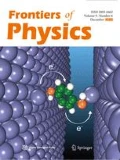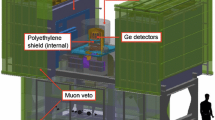Abstract
It is believed that weakly interacting massive particles (WIMPs) are candidates for dark matter (DM) in our universe which come from outer space and might interact with the standard model (SM) matter of our detectors on the earth. Many collaborations in the world are carrying out various experiments to directly detect DM particles. China Jinping underground Laboratory (CJPL) is the deepest underground laboratory in the world and provides a very promising environment for DM search. China Dark matter EXperiment (CDEX) is going to directly detect the WIMP flux with high sensitivity in the low WIMP-mass region. Both CJPL and CDEX have achieved a remarkable progress in recent three years. CDEX employs a point-contact germanium (PCGe) semi-conductor detector whose energy threshold is less than 300 eV. In this report we present the measurement results of muon flux, monitoring of radioactivity and radon concentration carried out in CJPL, as well describing the structure and performance of the 1 kg-PCGe detector in CDEX-1 and 10 kg-PCGe detector array in CDEX-10 including the detectors, electronics, shielding and cooling systems. Finally we discuss the physics goals of CDEX-1, CDEX-10 and the future CDEX-1T experiments.
Similar content being viewed by others
References and notes
F. Zwicky, On the masses of nebulae and of clusters of nebulae, Astrophys. J., 1937, 86: 217
V. Rubin and W. K. J. Ford, Rotation of the andromeda nebula from a spectroscopic survey of emission regions, Astrophys. J., 1970, 159: 379
V. Rubin, W. K. J. Ford, and N. Thonnard, Rotational properties of 21 SC galaxies with a large range of luminosities and radii, from NGC 4605 /R = 4 kpc/ to UGC 2885 /R = 122 kpc/, Astrophys. J., 1980, 238: 471
V. Rubin, D. Burstein, W. K. J. Ford, and N. Thonnard, Rotation velocities of 16 SA galaxies and a comparison of Sa, Sb, and SC rotation properties, Astrophys. J., 1985, 289: 81
D. Clowe, M. Bradac, A. H. Gonzalez, M. Markevitch, S. W. Randall, C. Jones, and D. Zaritsky, A direct empirical proof of the existence of dark matter, Astrophys. J., 2006, 648(2): L109
J. Beringer, et al. [Particle Data Group], The review of particle physics, Phys. Rev. D, 2012, 86: 010001
Planck Collaboration, Planck 2013 results. XVI. cosmological parameters, arXiv: 1303.5076v1, 2013
V. Trimble, Existence and nature of dark matter in the universe, Annu. Rev. Astron. Astrophys., 1987, 25(1): 425
G. Jungman, M. Kamionkowski, and K. Griest, Supersymmetric dark matter, Phys. Rep., 1996, 267(5–6): 195
L. Bergstrom, Dark matter candidates, New J. Phys., 2009, 11(10): 105006
J. L. Feng, Dark matter candidates from particle physics and methods of detection, arXiv: 1003.0904, 2010
R. J. Gaitskell, Direct detection of dark matter, Ann. Rev. Nucl. Part. Sci., 2004, 54(1): 315
X.G. He, H. C. Tsai, T. Li, and X. Q. Li, Scalar darkmatter effects in Higgs and top quark decays, Mod. Phys. Lett. A, 2007, 22(25n28): 2121
X. He, T. Li, X. Q. Li, J. Tandean, and H. C. Tsai, Constraints on scalar dark matter from direct experimental searches, Phys. Rev. D, 2009, 79(2): 023521
A. Beylyaev, M. T. Frandsen, S. Sarkar, and F. Sannino, Mixed dark matter from Technicolor, Phys. Rev. D, 2011, 83(1): 015007, and the references therein
H. P. An, S. L. Chen, R. N. Mohapatra, S. Nussinov, and Y. Zhang, Energy dependence of direct detection cross-section for asymmetric mirror dark matter, Phys. Rev. D, 2010, 82: 023533, arXiv: 1004.3296
J.-W. Cui, H.-J. He, L.-C. Lu, and F.-R. Yin, Spontaneous mirror parity violation, common origin of matter and dark matter, and the LHC Signatures, Phys. Rev. D, 2012, 85: 096003, arXiv: 1110.6893
M. Gilloz, A. von Manteuffel, P. Schwaller, and D. Wyler, The little skyrmion: new dark matter for little Higgs models, J. High Energy Phys., 2011, 1103: 48, and references therein, arXiv: 1012.5288v2
J. Lavalle, J. M. Alimi, and A. Fuözfa, Cosmic ray positron excess: Is the dark matter solution a good bet? AIP Conf. Proc., 2010, 24: 398
R. Yang, J. Chang, and J. Wu, A possible explanation for the electron/positron excess of ATIC/PAMELA, Res. Astro. Astrophys., 2010, 10(1): 39, and references therein
M. Amenomori, et al. [Tibet AS-gamma Collaboration], Cosmic-ray energy spectrum around the knee observed with the Tibet air-shower experiment, Astrophys. Space Sci. Trans., 2011, 7(1): 15
M. Aguilar, et al. [AMS Collaboration], First result from the alpha magnetic spectrometer on the international space station: Precision measurement of the positron fraction in primary cosmic rays of 0.5-350 GeV, Phys. Rev. Lett., 2013, 110(14): 141102
K. Bernabei, P. Belli, F. Cappella, R. Cerulli, C. J. Dai, A. d’Angelo, H. L. He, A. Incicchitti, H. H. Kuang, J. M. Ma, F. Montecchia, F. Nozzoli, D. Prosperi, X. D. Sheng, and Z. P. Ye, First results from DAMA/LIBRA and the combined results with DAMA/NaI, Eur. Phys. J. C, 2008, 56(3): 333
K. Bernabei, P. Belli, F. Cappella, R. Cerulli, C. J. Dai, A. d’Angelo, H. L. He, A. Incicchitti, H. H. Kuang, X. H. Ma, F. Montecchia, F. Nozzoli, D. Prosperi, X. D. Sheng, R. G. Wang, and Z. P. Ye, New results from DAMA/LIBRA, Eur. Phys. J. C, 2010, 67(1–2): 39
C. Aalseth, P. S. Barbeau, N. S. Bowden, B. Cabrera-Palmer, et al., Results from a search for light-mass dark matter with a p-type point contact germanium detector, Phys. Rev. Lett., 2011, 106(13): 131301
P. Brink, Z. Ahmed, D. S. Akerib, C. N. Bailey, et al., The cryogenic dark matter search (CDMS): Present status and future, AIP Conf. Proc., 2009, 1182: 260
G. Angloher, et al. [CRESST Collaboration], Results from 730 kg days of the CRESST-II dark matter search, arXiv: 1109.0702, 2011
J. Angle, et al. [XENON10 Collaboration], Search for light dark matter in XENON10 data, Phys. Rev. Lett., 2011, 107: 051301
R. Agnese, et al. [CDMS Collaboration], Dark matter search results using the silicon detectors of CDMS II, arXiv: 1304.4279v2, 2013
M. T. Frandsen, F. Kahlhoefer, C. McCabe, S. Sarkar, and K. Schmidt-Hoberg, The unbearable lightness of being: CDMS versus XENON, arXiv: 1304.6066v1, 2013
X. G. He and J. Tandean, Low-mass dark-matter hint from CDMS II, Higgs boson at LHC, and Darkon models, arXiv: 1304.6058v1, 2013
E. Aprile, et al. [XENON 100 Collaboration], Dark matter results from 225 live days of XENON100 data, arXiv: 1207.5988v2, 2013
J. Angle, et al. [XENON Collaboration], Limits on spin-dependent WIMP-nucleon cross-sections from the XENON10 experiment, Phys. Rev. Lett., 2008, 101(9): 091301
M. T. Ressell, M. Aufderheide, S. Bloom, K. Griest, G. Mathews, and D. Resler, Nuclear shell model calculations of neutralino-nucleus cross-sections for 29Si and 73Ge, Phys. Rev. D, 1993, 48(12): 5519
G. Griest, Cross-sections, relic abundance, and detection rates for neutralino dark matter, Phys. Rev. D, 1988, 15(8): 2357
C. L. Shan, Effects of residue background events in direct dark matter detection experiments on the estimation of the spin-independent WIMP-nucleon coupling, arXiv: 1103.4049v2, 2011
C. L. Shan, Estimating the spin-independent WIMP-nucleon coupling from direct dark matter detection data, arXiv: 1103.0481v2, 2011
V. Barger, W.-Y. Keung, and G. Shaughnessy, Spin dependence of dark matter scattering, Phys. Rev. D, 2008, 78: 056007, arXiv: 0806.1962
Y. Tzeng and T. T. S. Kuo, Dark matter-nucleus scattering, 14th International Conference on Particles and Nuclei (PANIC 96): C96-05-22, 479
M. T. Ressell, M. Aufderheide, S. Bloom, K. Griest, G. Mathews, and D. Resler, Nuclear shell model calculations of neutralino-nucleus cross-sections for 29Si and 73Ge, Phys. Rev. D, 1993, 48(12): 5519
M. T. Ressell and D. J. Dean, Spin-dependent neutralinonucleus scattering for A127 nuclei, Phys. Rev. C, 1997, 56(1): 535
J. Engel, S. Pittel, and P. Vogel, Nuclear physics of dark matter detection, Int. J. Mod. Phys. E, 1992, 1: 1
J. Engel, Nuclear form factors for the scattering of weakly interacting massive particles, Phys. Lett. B, 1991, 264(1–2): 114
Q. Yue, J. P. Cheng, Y. J. Li, J. Li, and Z. J. Wang, Detection of WIMPs using low threshold HPGe detector, High Energy Physics and Nuclear Physics, 2004, 28(8): 877 (in Chinese)
X. Li, Q. Yue, Y. J. Li, J. Li, et al., Status of ULE-HPGe detector experiment for dark matter search, High Energy Physics and Nuclear Physics, 2007, 31(6): 564 (in Chinese)
S. T. Lin, et al. [TEXONO Collaboration], New limits on spin-independent and spin-dependent couplings of low-mass WIMP dark matter with a germanium detector at a threshold of 220 eV, Phys. Rev. D, 2009, 79(6): 061101 (R)
C. E. Aalseth, et al. [CoGeNT Collaboration], Results from a search for light-mass dark matter with a p-type point contact germanium detector, Phys. Rev. Lett., 2011, 106(13): 131301
C. E. Aalseth, et al. [CoGeNT Collaboration], Search for an annual modulation in a p-type point contact germanium dark matter detector, Phys. Rev. Lett., 2011, 107(14): 141301
Majorana Collaboration, http://www.npl.washington.edu/majorana/
GERDA Collaboration, http://www.mpi-hd.mpg.de/gerda/
K. J. Kang, J. P. Cheng, Y. H. Chen, Y. J. Li, M. B. Shen, S. Y. Wu, and Q. Yue, Status and prospects of a deep underground laboratory in China, J. Phys.: Conf. Ser., 2010, 203(1): 012028
D. Normile, Chinese scientists hope to make deepest, darkest dreams come true, Science, 2009, 324(5932): 1246
G. Heusser, Low-radioactivity background techniques, Ann. Rev. Nucl. Part. Sci., 1995, 45(1): 543
Canberra, http://www.canberra.com/
Chinalco Luoyang Copper Co, Ltd, http://www.lycopper.cn
ORTEC, http://www.ortec-online.com
Y. C. Wu, et al. [CDEX Collaboration], Measurement of cosmic ray flux in China Jinping underground laboratory, arXiv: 1305.0899, 2013
Saphymo, http://saphymo.de
P. N. Luke, F. S. Goulding, N. W. Madden, and R. H. Pehl, Low capacitance large volume shaped-field germanium detector, IEEE Trans. Nucl. Sci., 1989, 36(1): 926
P. S. Barbeau, J. I. Collar, and O. Tench, Large-mass ultralow noise germanium detectors: performance and applications in neutrino and astroparticle physics, J. Cosmol. Astropart. Phys., 2007, 09: 009
AMPTEK, http://www.amptek.com
TEK, http://www.tek.com
CDMS Collaboration, http://cdms.berkeley.edu
XENON Collaboration, http://xenon.astro.columbia.edu
CRESST Collaboration, http://www.cresst.de
C. Aalseth, P. S. Barbeau, J. Colaresi, J. I. Collar, et al., Search for an annual modulation in a p-type point contact germanium dark matter detector, Phys. Rev. Lett., 2011, 107(14): 141301
M. G. Marino, Dark matter physics with P-type pointcontact germanium detectors: Extending the physics reach of the Majorana experiment, Ph.D. Dissertation, University of Washington, 2010
From a talk given by J. F. Wilkerson in Tsinghua University in 2011
Author information
Authors and Affiliations
Consortia
Corresponding authors
Additional information
Participate as TEXONO members.
Rights and permissions
About this article
Cite this article
Kang, KJ., Cheng, JP., Li, J. et al. Introduction to the CDEX experiment. Front. Phys. 8, 412–437 (2013). https://doi.org/10.1007/s11467-013-0349-1
Received:
Accepted:
Published:
Issue Date:
DOI: https://doi.org/10.1007/s11467-013-0349-1




